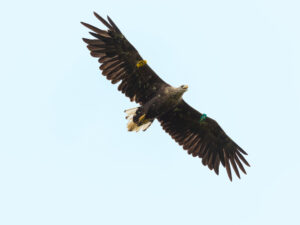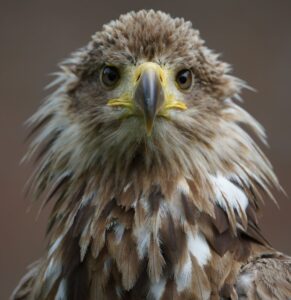White-Tailed Eagles: First breeding pair confirmed in Northern Ireland in over 150 years.
White-tailed Eagles have bred in Northern Ireland for the first time in more than 150 years in Co. Fermanagh.
News of the discovery was welcomed by the Northern Ireland Raptor Study Group (NIRSG) and RSPB.
 White-tailed Eagles, a native component of Irish wildlife, were reintroduced to Ireland by the Golden Eagle Trust (GET) and National Parks and Wildlife Service (NPWS) between 2007 and 2011, with the aim of establishing a viable population following extinction from Ireland in the late 19th century.
White-tailed Eagles, a native component of Irish wildlife, were reintroduced to Ireland by the Golden Eagle Trust (GET) and National Parks and Wildlife Service (NPWS) between 2007 and 2011, with the aim of establishing a viable population following extinction from Ireland in the late 19th century.
From 2007 to 2011, 100 eagle chicks were brought from Norway and were released in Killarney National Park, Co. Kerry. Phase 2 of the reintroduction, by NPWS, continued in 2020 with more young individuals released at a number of sites across Ireland to bolster the population. Released birds were wing-tagged, with tag colours relating to their year of birth and codes to identify individuals, and many were fitted with satellite tags to provide accurate details of their locations.
The pair that have bred in Northern Ireland are only four years old and were released on the shores of Lough Derg, Co Tipperary in 2020, having been brought from Norway in phase 2 of the Irish reintroduction programme. It is an incredible achievement that this pair of first-time breeders, have successfully fledged one chick. The success of this pioneering couple confirms that the wetlands, woodlands and farmlands of Co. Fermanagh provide ideal habitats for this species.
The White-tailed Eagle, or ‘sea eagle’, is the UK’s largest bird of prey, standing at almost 1 meter tall, with a huge wingspan of up to 2.4 metres and a distinctive white tail, as their name suggests. The wings are very broad, and the birds are often described as a ‘flying barn door’.
Young White-tailed Eagles often roam widely in their first few years of life, before finding a breeding territory and a mate. They are found near open water, either coastal or fresh. They can live to over 20 years of age, and usually begin breeding at 5 years old. They depend on the availability of large, mature trees in undisturbed areas in which to build their nests and good quality foraging and fishing habitats.
Dr Eimear Rooney from NIRSG said “The confirmation of this eagle species breeding in Northern Ireland corrects a multi-generational absence, symbolising the restoration of a once extinct species and highlighting the importance of wetlands, woodlands and farmland habitats on which many of our raptors depend”.
“From reviewing satellite data provided by NPWS we had an idea that the birds were nesting, but with young eagles nothing is guaranteed. I can’t describe the adrenalin rush the moment I saw the chick earlier this year and confirmed that the birds were not only nesting but had successfully reared a chick” she said.
Dean Jones, Investigations Officer from RSPB NI said: “The return of breeding white-tailed eagles to Northern Ireland is a true testament to the power of conservation and really showcases the awe-inspiring resilience and adaptability of our natural world. The poisoning of the two white-tailed eagles in Glenwherry in May 2023 was devastating, however, to have this pair breeding successfully, under the protection of a caring local farmer, really illustrates how humans and birds of prey can exist in harmony.”
Dr Marc Ruddock, from the NIRSG said “We had been anticipating this for a few years and the reintroduction programmes, has resulted in real conservation successes across the Island of Ireland. It’s a great result for the dedication and hard work of many individuals for many years and testament to the resilience of nature and wildlife in its capacity for restoration and renewal if given the space and habitats to thrive.”
 Gregory Woulahan, Operations Director from RSPB NI praised the efforts of the local farmer whose actions to keep the site private and minimise disturbance no doubt created the conditions for these young birds to rear their first chick. It is hoped this chick will reach adulthood and return to breed in 4-6 years boosting the population of these birds alongside creating tourism opportunities for the rural economy and the implementation of further efforts to boost and restore spaces for nature.
Gregory Woulahan, Operations Director from RSPB NI praised the efforts of the local farmer whose actions to keep the site private and minimise disturbance no doubt created the conditions for these young birds to rear their first chick. It is hoped this chick will reach adulthood and return to breed in 4-6 years boosting the population of these birds alongside creating tourism opportunities for the rural economy and the implementation of further efforts to boost and restore spaces for nature.
A special licence is required to disturb nesting White tailed Eagles, visit nest sites or take photos or videos at nest sites.
More information can also be found on the eagle leaflet that we prepared in 2014 about Golden Eagles and White-Tailed Eagle Eagle leaflet v1.pdf (dropbox.com)
For further information or to arrange an interview, please contact:
Gemma McAdam, Country Communications Manager, RSPB NI, 07395 852414, gemma.mcadam@rspb.org.uk
Dr Eimear Rooney, Raptor Officer, NIRSG 07743068931 raptorofficerni@gmail.com